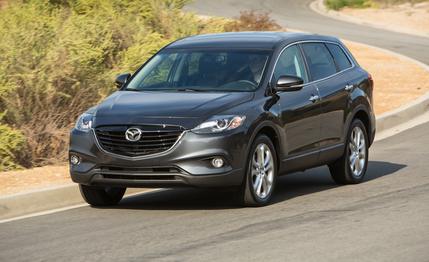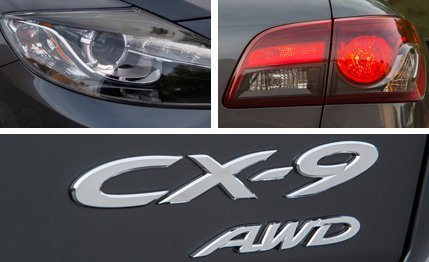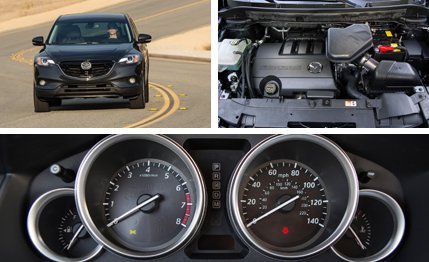 Instrumented Test
TESTED
Instrumented Test
TESTED
If a Mazda CX-9 were to appear as a character in a hypothetical second Cars sequel, we could imagine a pair of seasoned body-on-frame SUVs gossiping in a suburban driveway: “Did you see the badge on him? Can you believe he carried seven passengers?” It’s a fact: The company based in Hiroshima, Japan, that is known for sports cars makes a crossover SUV with seven seats.
And it’s kinda fun to drive, to boot.
The CX-9 is just what you imagine would happen if you cut loose the folks who created the Miata, RX-7, and 3 to design and engineer a Zoom-Zoom-worthy family hauler. Here at Car and Driver, the CX-9 has been at or near the top of our drop-down menu of favorite three-row crossovers since its 2007 introduction. To wit, the CX-9 was a 2008 5Best Trucks winner, it went toe-to-toe with the Honda Pilot for top honors in a seven-passenger crossover shootout (falling short by three measly points), and we completed a satisfying 40,000-mile test with a 2008 model.
Straight from the don’t-fix-it-if-it-ain’t-broke department, the 2013 CX-9 gets a face lift but few other tweaks, and the powertrain and the chassis remain largely unchanged. Most prominent is a new smacker based on Mazda’s latest Kodo design language, as seen on recent debutantes like the new CX-5 and 2014 6. Gone are the double chin and the exaggerated Cheshire-cat smiley face that festooned 2010–12 models. Other 2013 exterior tweaks include a switch from oval to round exhaust outlets and new, hawk-eye-like bixenon headlights. The latter are accented by LED daytime running lamps on the uplevel Grand Touring model tested here.

Big—but Doesn’t Drive Like It
The CX-9’s steeply raked windshield and long, tapered nose make it stand out in a parking lot full of blocky SUVs. To the casual eye, the CX-9 is a slimmed-down crossover, but that’s not necessarily due to a dainty footprint—it stretches more than 200 inches nose to tail. That’s more than a foot longer than Toyota’s Highlander, nine inches longer than the Honda Pilot, and three inches longer than Ford’s Explorer. The only three-row crossovers longer than the CX-9 are GM’s Traverse/Acadia/Enclave trio.
What is slimming is the way the CX-9 drives. Although its stability-control-inhibited 0.79-g skidpad figure is virtually identical to that of other three-row crossovers in the class, the big Mazda’s response to driver inputs is linear and reassuring, and we recorded a competitive 177-foot stopping distance from 70 to 0 mph. With sharp steering, crisp top-of-pedal brake response, and well-damped body movement, the CX-9 shrink-wraps itself around the driver, behaving more like a sporty hatchback than a commodious SUV.

Benefiting from Mazda’s previous association with Ford, the CX-9 started life as a stretched Ford Edge (itself a derivative spun from first-gen Mazda 6 bones), dipping into the blue oval’s parts bin while rebalancing the vehicle around Mazda sensibilities. It’s no hot rod, but the CX-9 has ample power for passing, merging, and taking advantage of opportunities in traffic. It helps that the Mazda is lighter than many of its mainstream three-row crossover competitors—183 fewer pounds than the Chevy Traverse we most recently tested and 189 fewer than the Explorer XLT from a recent comparo.
The highly touted Skyactiv Technology used to good effect on the CX-5—with engine direct injection and other tweaks—is not applied in the CX-9, however. Mazda makes do with an older version of Ford’s 3.7-liter DOHC V-6 with variable valve timing on the intake side only, producing 273 horsepower and 270 lb-ft of torque. The programming of the six-speed automatic helps put some zoom in the 4558-pound crossover’s acceleration, offering true manumatic shifting for full driver control. The gauge cluster prominently displays the specific gear the transmission is in even while in drive—a sporty touch rare in this segment.